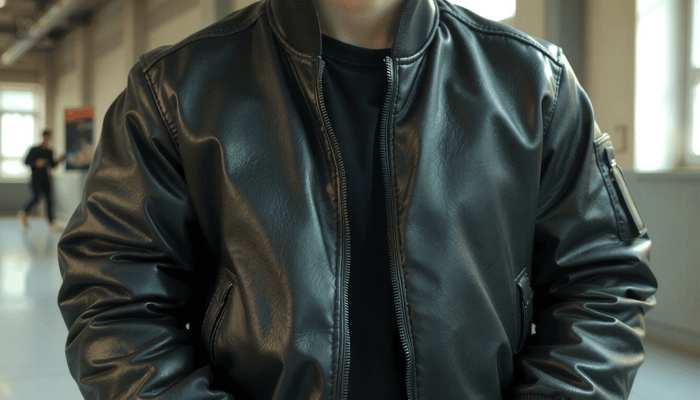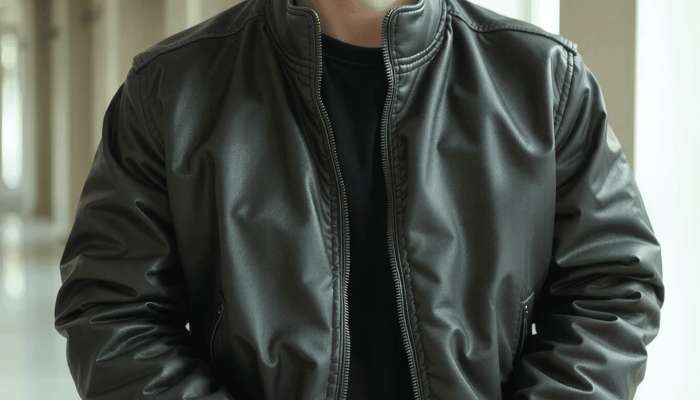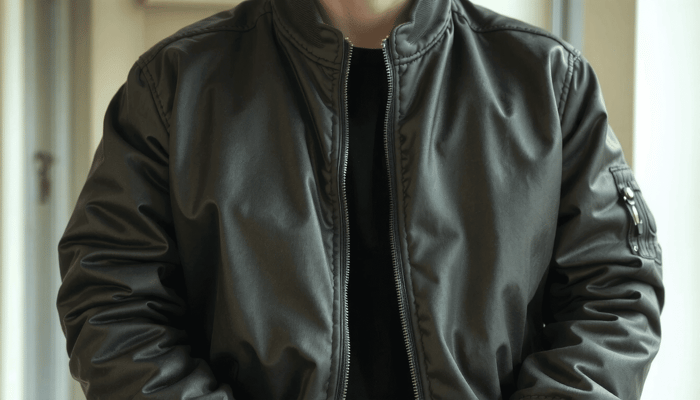What is a Bomber Jacket? The Ultimate Guide to Fashion's Classic Piece
 Mr. Eton Yip | 32+ Year Garment Manufacturing Expert & Founder of Eton Garment
Garment Industry
Mr. Eton Yip | 32+ Year Garment Manufacturing Expert & Founder of Eton Garment
Garment Industry
July 22nd, 2025
9 minute read
Table of Contents
A bomber jacket is a short, waist-length outerwear piece. It has a zipper in the front, a defined neckline, and ribbed cuffs and hem. Dictionary.com describes it as a short jacket...resembling those worn by World War II bomber crews. Such clothing began as military equipment. Today it is among the most popular fashion items all over the world.
This guide tells the complete story of this iconic jacket. We will focus on its essential features and highlight its extensive history. You will receive expert advice on how to choose the best one that suits you, plus answers to common questions.

The Characteristics of a Classic
The bomber jacket's durable design comes from its excellent functionality. Each part has its role in helping pilots navigate under difficult situations. Understanding these features explains what a bomber jacket is and why its design still works today.
Here are the main parts that a true bomber jacket has to have:
Waist-Length Cut: The short style was vital. This allowed pilots to be comfortable sitting and moving in tight cockpits without the jacket bunching up.
Ribbed Cuffs and Hem: These stretchy, knitted bands are the jacket's signature feature. They fit snugly against wrists and waist to trap body heat. Most importantly, they keep cold wind from getting inside the jacket at high altitudes.
Front Closure: Early flight jackets were designed with buttons. They were soon replaced by zippers. Zippers were quicker and more secure. They also offered better protection from the elements.
Collar Styles: The collars varied according to the model and purpose. Early leather jackets mostly had a stand-up knit collar or a huge, fur-lined collar for extra warmth. The later MA-1 model had a simple, ribbed knit collar. This design wouldn't interfere with a parachute harness.
Lining: The lining provided insulation and, later, helped with survival. Many bombers have quilted lining for warmth. The iconic MA-1 introduced a bright "International Orange" lining. This allowed a downed pilot to reverse the jacket for high visibility to rescue crews.
From the Cockpit to the Catwalk
The bomber jacket's history is fascinating. It illustrates technological innovation and cultural adoption. From a military requirement to a fashion statement, its journey took over a century.
WWI Origins: The Beginning of Flight Jackets
The story begins in the open-air cockpits of World War I. They had no insulation. Pilots faced freezing temperatures, and regular uniforms weren't warm enough. This urgent need led to the first specialized flight jackets. This was the start of their origins in military apparel.

In 1917, the U.S. Army set up an Aviation Clothing Board. Their objective was to create practical aviator gear. Early models were long coats made of heavy-duty leather, often lined with fur and designed purely for warmth.
WWII and the Iconic A-2 and G-1
During World War II, the flight jacket took the shape we know today. The Type A-2 jacket was issued by the U.S. Army Air Forces and became the classic American pilot's jacket.
The A-2 was usually made from tough horsehide or goatskin. It had two large front flap pockets, knit cuffs and a waistband, a shirt-style collar, and shoulder tabs. It was more than just a uniform. Pilots frequently personalized their A-2s with squadron patches and hand-painted artwork, turning them into symbols of identity and pride.
Crews in high-altitude bombers like the B-17 needed even more insulation. This resulted in the introduction of the B-3 jacket. It was a bulky sheepskin coat that provided huge amounts of warmth in unpressurized cabins where temperatures could drop far below zero.
The Jet Age and the MA-1

The jet age arrived in the late 1940s and 1950s, bringing new requirements. Jets could fly higher and faster. Cockpits became more streamlined and filled with new equipment. The bulky leather jackets of WWII were no longer practical.
Nylon replaced leather. This newer material was lightweight and water-resistant. The military bomber jacket was made to be versatile for functionality. Nylon worked better with new temperature ranges and was less bulky in the cockpit. This change created the most famous model: the MA-1 flight jacket.
The MA-1 was first made in the 1950s. It had a sage green nylon shell with the famous reversible orange lining used to signal for rescue. It also came with a zippered utility pocket on the left sleeve. Its knitted collar replaced previous fur and leather versions, making it compatible with new helmet designs and parachute harnesses.
From the Subculture to the Masses
After the wars, military surplus stores sold flight jackets to the public. In the following decades, various subcultures adopted the bomber jacket, transforming it from military hardware into a symbol of cool.
In the 1960s, British mods and skinheads adopted the MA-1. In Hollywood, style icons such as Marlon Brando and Steve McQueen made it a ruggedly masculine wardrobe staple. By the 1980s and beyond, it had made its way into music, film, and even high fashion, proving its versatility and timeless charm.
How to Find the Best Bomber Jacket
Selecting the perfect bomber jacket means considering fit, material, and your personal style. With its rich history as a piece of clothing, its modern versions offer many choices.
Finding Your Perfect Fit Is the Most Important Step
Getting the fit right is the most important step. Look for shoulder seams that sit right on the edge of your shoulder bone. They shouldn't droop down your arm.

A classic fit stays true to the jacket's military origins. It has more room in the chest and shoulders for layering and movement. A modern or slim fit is more tailored to the body, offering a sharper, more contemporary look.
Whatever the cut, a bomber should feel snug at the ribbed hem and cuffs. You should have enough room to layer a t-shirt or light sweater underneath, and it shouldn't feel tight across your back or chest.
Choosing the Right Material
The material determines the jacket's look, feel, and function. Each fabric gives the jacket its character.
- Nylon: The classic MA-1 material. It's lightweight, durable, and often has a slight shine. Nylon bombers are incredibly versatile and are perfect for spring and fall.
- Leather: The original material. A leather bomber is a true investment piece. It's tough, durable, and develops a beautiful, unique patina over time. It offers fantastic wind protection and a substantial style impact.
- Suede: A more luxurious and softer alternative to traditional leather. It provides a sophisticated, textured look but needs more careful maintenance and protection from water.
- Wool/Cotton: These natural fibers offer a more casual, sometimes preppy, take on the bomber shape. They're breathable and comfortable, perfect for a smart-casual look.
From Innovation to Personalization
Today, designers are constantly reinventing the bomber jacket. You can find longer versions, oversized fits, and jackets made from unique fabrics. Patterns, embroidery, and bold colors have also become common.
For those who want a truly personal garment, customization is an excellent option. Many people want clothing that is uniquely theirs. Companies like Etongarment specialize in custom clothing, allowing for the creation of personalized bomber jackets that reflect an individual style or company identity.
Summary: A Timeless Essential Every Wardrobe Needs
The bomber jacket has stood the test of time. This once life-saving military device has become a symbol of fashion worldwide. Its history is woven into its very design—a perfect example of functional and aesthetic form.
More than just a trend, the bomber jacket is a true wardrobe essential. It's a versatile, stylish, and practical piece of outerwear that deserves a place in any modern collection.
Frequently Asked Questions
What is the difference between a bomber jacket and a flight jacket?
The terms are mostly the same in modern fashion. Historically, "flight jacket" is the broader military term for any jacket worn by aircrew. "Bomber jacket" became a popular nickname for specific models, like the A-2 and MA-1, worn by bomber plane crews. Today, when you ask what is a bomber jacket, the answer is virtually the same as for a flight jacket.
Do people still wear bomber jackets?
Certainly. The bomber jacket is a classic piece of outerwear that has stayed in style for decades. While specific trends in fit (like slim vs. oversized) or color may change, its basic shape is considered timeless. Designers constantly reinterpret it.
When is the best time to wear a bomber jacket?
This depends on the material. Lightweight nylon, cotton, or satin bombers are ideal for spring and fall. Heavier versions made from leather, wool, or those with quilted insulation are excellent for staying warm and stylish during the cold winter months.
Can you wear a bomber jacket in the rain?
This depends on the material. Nylon and certain treated synthetic bombers are water-resistant and can handle light rain. However, traditional materials like suede and untreated leather can be damaged by water and should be kept dry. Always check the care label for specific instructions.
In what ways does a bomber jacket stand apart from a varsity jacket?
While they share a similar waist-length, zippered shape, their origins and details are different. Varsity jackets (or letterman jackets) come from college traditions. They typically have a wool body with contrasting leather sleeves, chenille patches (letters), and school colors. Bomber jackets have military origins and are characterized by uniform materials and functional details like sleeve pockets and specific collar styles.
Related Articles
Today's Jacket Dilemma: How to Make the Right Choice
5 minute read
July 22nd, 2025
Every day we wake up and face the same scenario. Check out the weather. Look at the closet. Ask... more »
The Ultimate Guide: How to Get a Jacket That Fits You Best
11 minute read
July 22nd, 2025
Shopping for a jacket online should be a fun, not a risky thing to do. We've all had that horrible... more »
Your Complete DIY Guide to Fixing a Jacket Zipper: From Getting Stuck to Replacing It
11 minute read
July 22nd, 2025
A malfunctioning zipper on your go-to jacket is a common cause of irritation. Such issues are common.... more »
A Barbour Jacket Is a Definitive British Element! The Complete Guide to This Icon
10 minute read
July 22nd, 2025
A Barbour jacket symbolizes the British identity. It is precisely made as it is outerwear made... more »
Chic & Warm: The Perfect Combinations Between Jacket and Formal Dress
10 minute read
July 21st, 2025
Finding a beautiful formal dress is like scoring a winning goal. However, the next step is the challenging... more »

